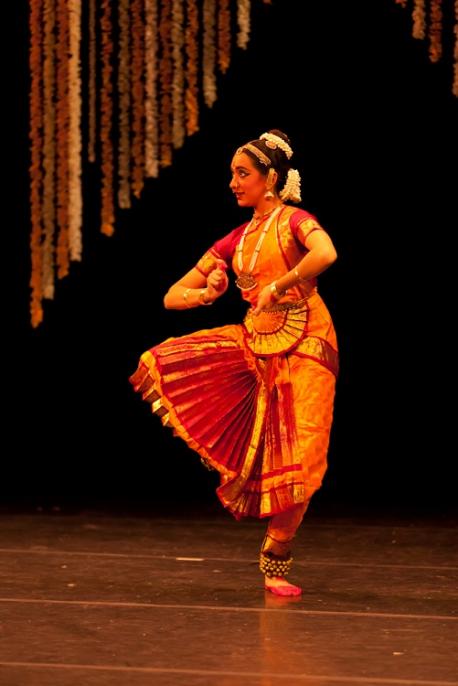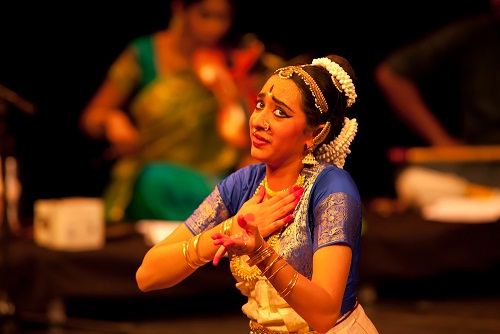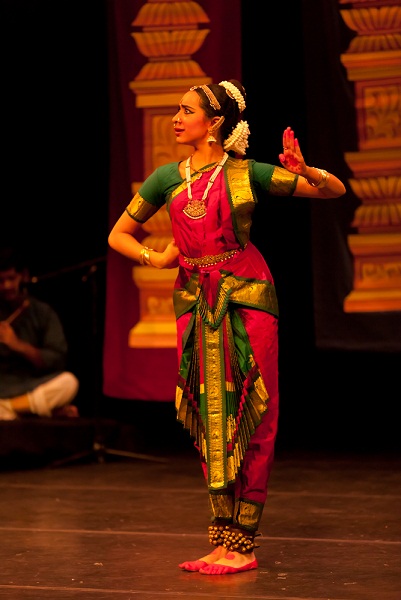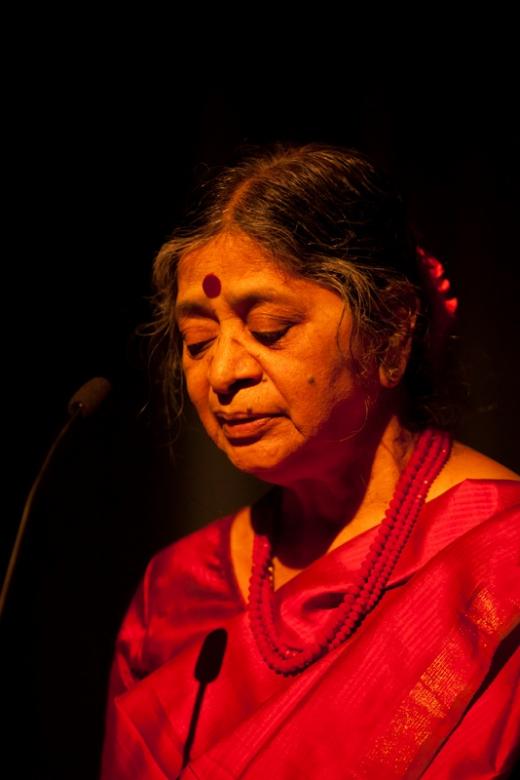Contribute
| Arangetram: Ananya Mahalingam-Dhingra |
Sunanda Narayanan
09/29/2011
Summer in Boston is also the unofficial “arangetram season†with its flurry of music and dance debuts each weekend. The summer months afford leisure from the regular school grind, when students of the classical arts can put in intensive hours of practice and gain the “growth spurt†in technique and stamina required for a full-length debut performance.
I had the pleasure of attending one such Bharatanatyam arangetram on September 17th of Ananya Mahalingam-Dhingra, disciple of Gurus Meena Subramanyam and Roja Kannan, at the Regis College Fine Arts Center in Weston, MA. Ananya, a sophomore at the Winsor School in Boston, has trained for nearly ten years under their guidance in Boston and in India, and presented the fruits of her training admirably in the Kalakshetra style, known for its unswerving adherence to tradition.
Ananya had the privilege of having her maternal grandmother render a moving prayer song that set the mood for the evening. She opened her performance with a lilting “Shri Vigna Rajam Bhajeâ€, a composition of Oothukkadu Venkatakavi, in praise of the elephant-headed Ganesha. Ananya’s quiet confidence from the outset was striking and was the product no doubt of tireless practice under the watchful eyes of both her Gurus. The alaripu that followed was set to the unusual Tisra-Dhruva talam, a cycle of eleven beats. The alternating switch in gait within each rhythmic cycle was maintained with ease and Guru Meena’s sollu kattu (collection of solfa syllables) was vibrant and engaging all through. The captivating Ragamalika Jatiswaram by the Tanjore quartet came next in the agenda and was neatly executed with adavus that were choreographed to suit the nuances of the musical passages, each set to a different ragam. It was interesting to note how the Sabdam that occurred next and that was also in Ragamalika and in the same Misra Chapu talam as the Jatiswaram, offered an entirely different pace and scope for presentation to the dancer. Where the misra chapu adavu sequences in the jatiswaram demanded speed and agility, those in the sabdam had a stately and old-world charm that provided a gentle contrast. The lyrics in praise of Devi were unusual for a Sabdam and Ananya did full justice to this piece with her elegant execution of both adavus and abhinaya.
“Senthil Mevum Deva Deva†– a masterpiece in Nilambari of violin maestro Lalgudi Jayaraman was the varnam presented next. The choreography included demanding jatis (pure dance sequences) and elaborate abhinaya (expressive) sequences where the dancer showcased her abundant talent in these dual aspects of Bharatanatyam. Ananya’s footwork was firm and precise and every movement was done with conviction and sincere effort. The lyrics in this varnam are an address from a young maiden to Lord Muruga declaring her devotion and love to him. Tales of Muruga’s exploits such as the episode of his marriage to Valli were recounted with involvement tempered with restraint, showing Ananya’s understanding of the lyrics and context.
Ananya commenced the post-intermission session with “Natanam Aadinaarâ€, the evergreen favorite among dancers. This item in praise of Nataraja packs flamboyant appeal in its lyrics and music and is an ideal vehicle to showcase the Ananda Tandavam or vigorous dance of Siva. Ananya’s poses and description of the form of Nataraja were evocative and stirred nostalgia among members of the audience who have seen this piece performed by legends in the field.
While the current trend is to include brisk and catchy contemporary items couched primarily in the Bhakti (devotional) sentiment in this section of a performance, it was heartening to see Ananya revert to the traditional padam and javali for her next two pieces of the Arangetram. These genres that were the mainstay of dancers some decades ago are often neglected because of the challenge they pose to the dancer in sustaining the sthayi or reigning mood and also to the musician, since they are not easy to render. The themes intrinsic to them are the day-to-day issues in the relationship between a heroine and her lover, and hold lasting appeal for any audience given their eternal relevance. Where the padam is slow and involved in its treatment of a sentiment, the javali is jauntier. Ananya handled the demands of both “Aduvum Solluval†(the padam) and “Enthati Kuluke†(the javali) with maturity and without self-consciousness. The emotive thread was sustained well and one could see how hard Ananya had worked to identify with the heroines and perspective of these two pieces.
The rendition of the Tillana in Mand ragam was energetic yet graceful and followed with fidelity the contours of this popular composition by Lalgudi Jayaraman. Ananya seemed just as poised executing this taxing and final piece in her Arangetram as she had her first and her sense of repose was truly remarkable in a debutante!
The orchestral support at the arangetram was of an extraordinarily high caliber and in no small means served to enhance the ambience of the evening. The vocalist, Gopalakrishnan Srikanth, embellished every movement in the choreography with his soulful music as did Sri Haribabu on the mridangam. The violin support from our own Rasika Murali was captivating and her “Niravadhi Sukha†in Ravichandrika played during a musical interlude was spirited and melodious. Vivek V. Krishna on the flute set the mood for each piece wonderfully through his raga preludes. Kriti Subramanyam was a lovely compere through the evening and her sweet voice and poetic explanations to each piece were much appreciated by the audience.
Ananya’s arangetram was elegant and aesthetic in all aspects of its presentation from the foyer décor, costuming, music, and the traditionally delineated dance items. It was heartwarming to note that in lieu of gifts, Ananya welcomed donations for a non-profit organization that she plans to set up in Chennai, India to enable underprivileged children to learn dance – the project appropriately entitled "Dance for Everyone" is being established under the guidance of Navarasa Dance Theatre. My very best wishes to Ananya in her pursuit of excellence in Bharatanatyam.
You may also access this article through our web-site http://www.lokvani.com/



